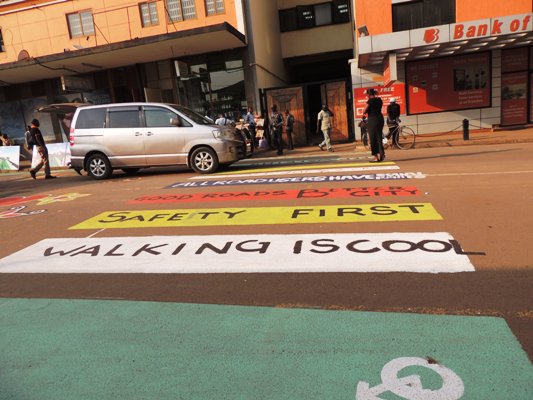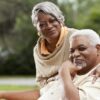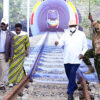Life & Style
Making Kampala more sexier, and fun
You will excuse us for starting with a rather pessimistic anecdote before introducing a wonderful idea that promises to transform Kampala into a more enjoyable city.
A few days to Christmas last year, Rose Namuli was knocked from behind by a speeding boda boda as she casually walked on a pavement along Kampala road.
Realising his mistake of knocking someone on a prohibited place, the cyclist picked up his motorcycle and sped off, leaving Namuli with injuries that made sure she spent Christmas in hospital nursing injuries. Despite the injuries, a number of people expressed relief she hadn’t been killed in the unfortunate accident, as indeed many have.
Several other accidents have happened in Kampala, often caused by boda boda cyclists, and other times by motorists for violating traffic rules such as driving on pavements, abusing one-way traffic rules etcetera.
Out of the sheer number of such incidents and their odd nature, some have come up with adaptation strategies and principles; one of them being that to survive in Kampala, you have to be a pessimist. For example, you must look on both sides of a one-way street just so you don’t get knocked by a boda guy speeding from an unexpected direction; While at the zebra crossing, pedestrians wait for motorists to pass, than the other way round.
Motorists too are not any safer while driving in traffic jam. They often lose lose wheel caps, mirrors and sometimes mobile phones to thieves who pretend to be innocent pedestrians.
It is against these widespread incidents of abuse of traffic rules and muggings experienced in Kampala that some have called into question the chances of success for a promising new idea by UN habitat for Humanity – for making Kampala more liveable and enjoyable through securing more spaces for pedestrians and cyclists.
Over the past three days, the UN organisation, famous for its largely successful concepts of developing cheaper housing projects in slum areas around the world, has been promoting a new idea which they say will make parts of Kampala more liveable, and enjoyable.
The key pillar of their idea is to create dedicated safe paths or streets in the city just for pedestrians through walking. This concept is anchored around the idea that roads are public spaces that must be enjoyed by all not just the privileged few who use them for driving.
In fact, UN habitat says that over the past five years of working with Kampala Capital City Authority (KCCA), they found through research, that 60 percent of Kampalans walk as opposed to moving in cars and taxis.
Reports from KCCA indicate that they have already bought into the idea and will very soon start to implement parts of this grand plan by closing a three kilometre stretch that joins Namirembe and Luwum Streets off to all forms of motorised traffic.
Besides the Luwum-Ben Kiwanuka, UN-Habitat has finalised a plan in which they have re-configured traffic flow in Kampala. The plan shows that pedestrians will have separate lanes from those used by motorists.
Carrying slogans such as Walking is Cool, All road users have same rights, UN Habitat hopes to transform people’s understanding of roads and streets as dangerous places to avoid even during heavy traffic jams.
Stefanie Holzwarth, the UN Habitat leader in Uganda, explained that preserving spaces for pedestrians including closing off some roads entirely shall bring more benefits beyond helping people burn off excess calories in their body.
“Preserving some spaces for walking would not only make people healthier, it reduces pollution from vehicles and can boost business as more people find it easier to navigate the city from just the fact that there’s a reduced risk of accidents,” said Holzwarth.
Being a new idea in Kampala, Holzwarth admitted that her team has faced mixed reactions from the public about the implementation. The greatest fear she said came from shop owners along Luwum street who feared that banning shop cars from accessing the busy streets will chase away buyers.
She however comforts them that experience gathered similar initiatives in other countries have revealed that rather chase customers, safer pedestrian only streets attract more customers.
Indeed her point reminds me of a memorable experience back in 2004 on my first trip to France. The medieval city of Besançon in Eastern France near the border with Switzerland, had closed off motorised traffic for some of its roads which transformed them into the most happening places of the city. Some of the most booming businesses such as coffee shops, book stores, high-end boutiques and restaurants were located on traffic-free lanes that were lined with beautiful flowers.
Whether or not the people of Kampala can embrace this new and promising shift, it appears will greatly depend on several other factors beyond simply blocking traffic.
Key among them is the sheer lack of enforcement of traffic rules particularly prohibiting motorists from parking and driving on pavements. In fact, stories of accidents happening at Zebra Crossing, are a reminder that it may not be the lack of walking spaces per se, but rather the failure by city dwellers, especially the motorists, to enforce the rule of law.
Keeping law and order on the streets to prevent muggers and pickpockets should be another key consideration by the city authorities so as to restore confidence among the shoppers that they can be safe anywhere anytime.
Ensuring a functional safe and secure, and affordable public transport system has been a key pillar of success for similar programmes in other cities around the world.
As William Odinga, a daily commuter from Gayaza to Kampala, observes, walking only makes sense if people are sure they will manage to catch a bus or a taxi somewhere in the city to take them back to their places of abode, which in the case of many Kampalans, is several miles away from Kampala down in Wakiso district.
The point is that good as these UN habitat ideas may sound, their realisation will require the participation of everyone, particularly the law enforcement agencies.
Comments




















